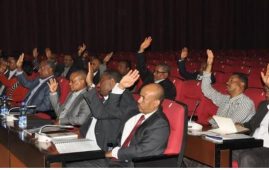In recent years, drawing parallels between Ethiopia and communist or autocratic regimes has become fashionable among EPRDF detractors. The tendency gained momentum in the last few month, including some western observers and bloggers who feared the results of the May 23/10 legislative elections could be the last nail on liberalism’s coffin.
western observers and bloggers who feared the results of the May 23/10 legislative elections could be the last nail on liberalism’s coffin.
However, as shown in the previous posts, it is erroneous, if not deceptive, to posit the margin of EPRDF’s election win and the length of the Premier’s tenure as events unheard of in liberal western democracies.[Click here to read: ‘Election-Win-EPRDF-Style’ in 8 Liberal Countries and How long is ‘too long’? Meet 10 Long-serving Western Leaders]
This post presents a list of political parties that ruled western/industrialized democracies for several decades.
‘Everything must be like something, so what is this like?’
Ethiopia’s ruling party EPRDF came to power in 1991 throwing the pro-soviet Military Junta. It led a coalition-like transitional government holding 32 seats in an 87-seats transitional government Council. Following the ratification of the Constitution, EPRDF won the first election held in 1995, and the following elections held in 2000, 2005, and 2010. Its fourth term begins in October 2010.
transitional government holding 32 seats in an 87-seats transitional government Council. Following the ratification of the Constitution, EPRDF won the first election held in 1995, and the following elections held in 2000, 2005, and 2010. Its fourth term begins in October 2010.
Here are 11 similar cases in the west.
Note that: This list is based on brief survey I undertook. Thus, it is likely there are long-serving western parties that are not include here.
The forgoing data is limited to western/industrialized democracies that have parliamentary system, same as Ethiopia. The parties listed below had been in power for four or more terms and/or for more than two decades.
I. Liberal-Democratic party
Ruled Japan uninterrupted for 39 years (1955-1994)
Totally, of the 54 years from 1955-2009, it ruled alone in all but the 2 years (1994-1996) when it shared power with Social Democrat Party, which provided the Prime Minister.
In addition, it held the majority of the seats of the upper house for 52 years (1955-2007).
II. Social Democratic Party
Ruled Sweden uninterrupted for 44 years (1932-1976).
Again, it was the governing party for 21 of the 24 years since 1982; i.e., 1982-1991 and 1994-2006.
III. Christian Democratic Party
Ruled Italy uninterrupted for 36 years (1945-1981).
In general, of the 50 years since 1945, it had been in power in all but 6 years (1981-2, 1983-87, 1992-3).
IV. Labour Party (formerly Mapai party)![]()
Ruled Israel uninterrupted for 29 years (1948-1977).
V. Liberal Party of Australia
Ruled Australia uninterrupted for 23 years (1949-1972).
In general, in the 35 years from 1949-1983, it was out of office only in three; i.e., 1972-75.
VI. CDU – Christian Democratic Union![]()
Ruled Germany Uninterrupted for 20 years (1949-1969).
VII. Christian People’s Party
(aka, Christen-Democratisch en Vlaams)
Ruled Belgium Uninterrupted for 20 years (1979-1999).
VIII. Conservative Party (Tory)![]()
Ruled Uniczted Kingdom Uninterrupted for four terms or 18 years (1979-1997).
IX. Liberal Party of Canada![]()
Ruled Canada for 20 or 21 years (1963-1984).
(There had been an 8 months political turmoil)
X. New-Zealand National Party![]()
Ruled New Zealand for 29 of the 35 years from 1949-1984.
It lost power twice -i.e., 1957-60 and 1972-75.
XI. CSV- Christian Social People’s Party
Governing Luxembourg uninterrupted for 30 years and counting (1979 – still).
CSV has always been the governing party for all but 5 years since 1918; i.e., 1974-1979.
Words About Words
‘Everything must be like something, so what is this like?’ It is a line from the late Edward Forster, a British writer. In fact, it is an intuitive tendency of the human mind. It also constitutes to one of logical reasoning. Properly applied, analogy enables us understand less known aspects of a thing, even predict future trends, based on what is known. Yet, it is also one of the oldest and most effective method of deception. The devil lies in the manner of its use.
This post, and the previous two,[‘Election-Win-EPRDF-Style’ in 8 Liberal Countries and How long is ‘too long’? Meet 10 Long-serving Western Leaders] are simply intended to show the fallacy of unwarranted analogies seen in several media outlets fore about a month. In short, big electoral wins, long-serving leaders and dominant parties are abundant in liberal democracy, thus do not necessarily evidence the emergence of autocracy.
‘Awra-Party’ is an Ethiopian equivalent for the term ‘dominant party’ coined by EPRDF to express its new status. The press release, following its executive council meeting last month, claimed ‘The fourth national election…created hotbed to deepen the multi party system through a dominant party system in the long run’.
However, weeks later, Merera Gudina baffled political observers by confusing ‘Awra party’ for ‘vanguard party’, an originally Leninist term indicating the status of the workers’ party during and after a proletarian revolution. One may choose to justify Merera’s misleading statement considering his frustration with the election result. Another may disparage the statement as it is highly unethical given the etiquette expected of an academician and a political leader; i.e., Chairperson of Oromo Peoples’ Congress and and V/Chair of MEDREK.
Yet, it is difficult to assume Merera, a PhD in political science, is ignorant of the huge difference of the two terms.
Here is a brief description of different party systems extracted from [historylearningsite.co.uk]
In a one-party state the position of the ruling party is guaranteed in a constitution and all forms of political opposition are banned by law. The ruling party controls all aspects of life within that state. The belief that a ruling party is all important to a state came from Lenin who believed that only one party – the Communists – could take the workers to their ultimate destiny and that the involvement of other parties would hinder this progress.
Two-party system is a state in which just two parties dominate. Other parties might exist but they have no political importance. America has the most obvious two-party political system with the Republicans and Democrats dominating the political scene. For the system to work, one of the parties must obtain a sufficient working majority after an election and it must be in a position to be able to govern without the support from the other party. A rotation of power is expected in this system.
The multi-party system is a system where more than two parties have some impact in a state’s political life. A multi-party system can lead to a coalition government as Germany and Italy have experienced. In Germany these have provided reasonably stable governments and a successful coalition can introduce an effective system of checks and balances on the government that can promote political moderation. Also many policy decisions take into account all views and interests. In Italy, coalition governments have not been a success; many have lasted less than one year. In Israel, recent governments have relied on the support of extreme minority groups to form a coalition government and this has created its own problems with such support being withdrawn on a whim or if those extreme parties feel that their own specific views are not being given enough support.
Dominant-party system: this is different from a one-party system. A party is quite capable within the political structure of a state, to become dominant to such an extent that victory at elections is considered a formality. This was the case under the Conservative governments of Margaret Thatcher and John Major. For 18 years (1979 to 1997), one party dominated politics in Britain.
In theory, the Conservatives could have lost any election during these 18 years. But such was the disarray of the opposition parties – especially Labour – that electoral victory was all but guaranteed. The elections of the 1980’s and 1990’s were fought with competition from other parties – hence there can be no comparison with a one-party state. During an extended stay in power, a dominant party can shape society through its policies.
During the Thatcher era, health, education, the state ownership of industry etc. were all massively changed and re-shaped. Society changed as a result of these political changes and this can only be done by a party having an extended stay in office.
Other features of a dominant system are:
*The party in power becomes complacent and sees that its position in power is ‘guaranteed’.
*The difference between the party in power and the state loses its distinction.
*An era of a dominant party is also an era when opposition parties are in total disarray.





